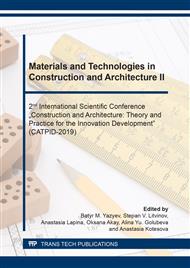p.551
p.556
p.564
p.570
p.577
p.583
p.589
p.596
p.601
Investigation of the Effect of Reinforcing Diaphragms Ribbed Panels on their Carrying Capacity
Abstract:
It has been established that structural analysis of ribbed panels on the carrying capacity of standard cross-sections is presented as reinforced concrete T-shaped or I-beams. However, this approach does not allow factoring in the effect of transversal ribs (diaphragms) on the accounting result for two groups of limit states. As a rule, transversal ribs are used in slabs with a greater width and serve mainly to provide its bending strength across the width mode transversely. It should be mentioned that a slab is calculated according to the beam theory based on structural mechanics models that characterize its behavior approximately in either direction along standard cross-sections. The theory of plate and shell can define the behavior under steady load of such a slab more precisely. However, applying this theory is attended with certain difficulties because of steel collaboration in multiple directions, as well as having material nonlinearity in the model. The work investigates ribbed floor panels which are modeled using modern software. The authors studied samples with prestressed and nonprestressed reinforcing as well as with or without transversal ribs. Finally, the authors find out that it is worth considering transversal ribs with regard to their reinforcement in stress calculations for standard cross-sections along a slab length. It can contribute to the development of correcting coefficients and specification of the section of the calculating theory of building constructions. The authors obtained innovative outcomes.
Info:
Periodical:
Pages:
577-582
Citation:
Online since:
December 2019
Authors:
Price:
Сopyright:
© 2020 Trans Tech Publications Ltd. All Rights Reserved
Share:
Citation:


